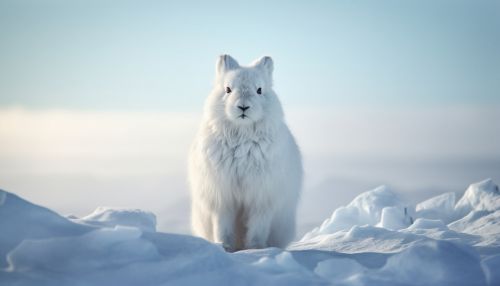Arctic hare
Taxonomy and Evolution
The Arctic hare (Lepus arcticus) is a species of hare highly adapted to living in the Arctic tundra and other icy biomes. It belongs to the family Leporidae, which includes rabbits and hares. The Arctic hare is one of the largest living lagomorphs, a group that also includes rabbits and pikas.


Physical Characteristics
Arctic hares are distinguished by their large size, with adults typically weighing between 2.5 to 5.5 kilograms. They possess a dense coat of fur that changes colour with the seasons, turning white in winter to provide camouflage against the snow, and blue-grey in summer to blend in with the tundra landscape. Their eyes are adapted for low light conditions, allowing them to forage and remain active during the long Arctic winter nights.
Distribution and Habitat
The Arctic hare is found throughout the northernmost regions of Greenland, the Canadian Arctic islands, and parts of mainland Canada. It inhabits the tundra biome, where it must contend with extreme cold, limited vegetation, and a host of predators. Despite these harsh conditions, the Arctic hare has evolved a number of adaptations that enable it to thrive in its environment.
Diet
Arctic hares are primarily herbivorous, feeding on a variety of plant material including leaves, stems, roots, and bark. During the winter months, when vegetation is scarce, they are known to eat snow to obtain water and may also resort to scavenging on animal carcasses.
Behaviour and Ecology
Arctic hares are primarily solitary animals, but they can form large aggregations in the winter, sometimes numbering in the hundreds. These groupings may serve to provide protection against predators and to increase foraging efficiency. Arctic hares are also known for their high-speed chases during mating season, a behaviour that is thought to be a form of sexual selection.
Reproduction
The breeding season for Arctic hares typically begins in April or May, with females giving birth to a single litter of one to eight leverets each year. The young are born fully furred and with their eyes open, and they are able to hop about within a few hours of birth. This precocial development is an adaptation to the harsh conditions of their habitat, as it allows the young hares to start foraging for food at an early age.
Conservation Status
The Arctic hare is currently listed as Least Concern on the IUCN Red List, due to its wide distribution and presumed large population. However, like all species in the Arctic, it faces potential threats from climate change, which is altering the tundra ecosystem and could impact the hare's food sources and habitat.
